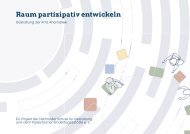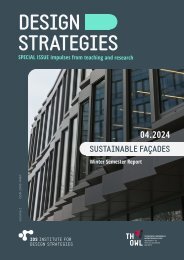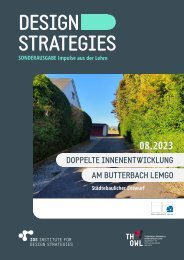urbanLab Magazin 2021 - Transformation
Erfolgreiche ePaper selbst erstellen
Machen Sie aus Ihren PDF Publikationen ein blätterbares Flipbook mit unserer einzigartigen Google optimierten e-Paper Software.
„<br />
Buildings that aim to receive a certification of sustainable<br />
construction might have to meet requirements of indoor<br />
environmental quality including acoustics.<br />
SOUND AND PUBLIC HEALTH<br />
Sound plays a key role in the way that<br />
people understand and engage in their<br />
environment, influencing their development,<br />
behaviour and communication.<br />
Whether listening to music, hearing<br />
traffic noise on a highway, or sleeping in<br />
bed at night, sound is always present,<br />
considering that even in a “very quiet”<br />
moment, human bodies are sound<br />
sources themselves (i.e. vocal sounds,<br />
heartbeats, breathing, digestion, etc.).<br />
The sounds that we subjectively, and<br />
sometimes collectively, identify as “unwanted”<br />
are considered noise. Noise<br />
could be unpleasant because of its<br />
quantity - a sound might be so loud that<br />
it is annoying or even painful regardless<br />
of its content, and/or because of its<br />
quality - a sound could be annoying without<br />
being loud. Also, there are sounds<br />
that are not received through the ears,<br />
as they might be out of our range of hearing,<br />
but they are certainly perceived<br />
in the form of vibrations.<br />
The acoustic environment is composed<br />
of the interaction between sounds and<br />
physical boundaries like landscape and<br />
infrastructure, to be received and interpreted<br />
individually from person to person.<br />
According to Pijanowski et al, (2011)<br />
sounds can be originated by geophysical<br />
sources such as the movement of<br />
water or wind, biological sources such<br />
as birds singing, crickets chirping or<br />
people speaking, and anthropological<br />
sources produced by humans such as<br />
the sounds of loud speakers, musical instruments,<br />
machines that produce road<br />
or air traffic noise, industrial noise, or<br />
any other sound originated by human<br />
technology.<br />
According to the World Health Organization,<br />
noise pollution is the second<br />
most harmful environmental stressor<br />
in Europe, behind air pollution, (WHO,<br />
2018), being accountable for about 20<br />
million reported adults suffering annoyance,<br />
8 million people suffering<br />
sleep disturbances, over 900,000 cases<br />
of hypertension and at least 10,000<br />
cases of premature death in Europe each<br />
year (European Environment Agency,<br />
2014), burdening health care systems,<br />
insurance companies, and the real estate<br />
market among other economies.<br />
URBAN NOISE AND BUILDING<br />
ENVELOPES<br />
Populated cities with dense urban environments<br />
are characteristically associated<br />
with noise pollution due to<br />
the greater amount of vehicles as well<br />
as industrial and leisure activities producing<br />
sounds that propagate through<br />
dense urban infrastructure. Building<br />
envelopes are the physical boundaries<br />
that separate exterior unconditioned<br />
space from indoor space, and facades,<br />
as part of the building envelope, fulfill<br />
different functions such as controlling<br />
the transfer of air, water, heat, light, and<br />
sound.<br />
Many people spend most of their time<br />
indoors, where traditionally, some level<br />
of acoustic treatment is considered<br />
when designing spaces like class rooms,<br />
hospitals, offices or auditoriums. This<br />
has a clear correlation to practices in the<br />
construction industry such as the use of<br />
acoustic panels on walls and ceilings to<br />
control the sound in rooms, or the use<br />
of acoustic insulation in windows and<br />
facades. Furthermore, buildings that<br />
aim to receive a certification of sustainable<br />
construction might have to meet<br />
requirements of indoor environmental<br />
quality including acoustics.<br />
Regarding the acoustics outside of<br />
buildings, facades occupy a significant<br />
amount of the vertical surfaces in the<br />
urban fabric being in direct contact<br />
HUMAN CENTERED DESIGN<br />
61
















